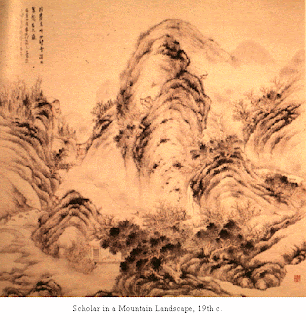Having read a lot about Zen before, I was very pleasantly surprised to listen to a section within an audio course on Japanese aesthetics in general... There is so much elaborate and hidden beauty, engulfed within its own lingual and artistic island (not just the material) , that grants a unique and deeply touching character.
In addition to the deep wisdom contained within the methods and traditions of the Samurai, Noh performances (the amazing zeami noh play of atsumori), Koans, the tea ceremony , bonzai , Amazing paintings, there were some literary gems and jewels that were very exciting to learn (e.g. Lady Murasaki and Sei Shonagon - especially the latter)...
Some samples below:
Wabi-sabi represents Japanese aesthetics and a Japanese world view centered on the acceptance of transience and imperfection. A view of beauty that is "imperfect, impermanent, and incomplete".
Mono no aware literally "the pathos of things", and also translated as "an empathy toward things", or "a sensitivity to ephemera". an awareness of impermanence or transience of things, and both a transient gentle sadness (or wistfulness) at their passing as well as a longer, deeper gentle sadness about this state being the reality of life.
In addition to the deep wisdom contained within the methods and traditions of the Samurai, Noh performances (the amazing zeami noh play of atsumori), Koans, the tea ceremony , bonzai , Amazing paintings, there were some literary gems and jewels that were very exciting to learn (e.g. Lady Murasaki and Sei Shonagon - especially the latter)...
Some samples below:
 |
| plum tree |
 |
| pine trees |
 |
| wabi-sabi tea bowl |
Wabi-sabi represents Japanese aesthetics and a Japanese world view centered on the acceptance of transience and imperfection. A view of beauty that is "imperfect, impermanent, and incomplete".
Mono no aware literally "the pathos of things", and also translated as "an empathy toward things", or "a sensitivity to ephemera". an awareness of impermanence or transience of things, and both a transient gentle sadness (or wistfulness) at their passing as well as a longer, deeper gentle sadness about this state being the reality of life.
On a deeper contemplative note, it is interesting to me the level of ritualization involved in systemizing and institutionalizing the process of meaning-making within society. This is evident especially in visual arts, the Noh, calligraphy, and others. In addition to ritualization there is a very powerful level of attention to detail and fragments, as well as a deep influence of Buddhist traditions of mindfulness, and awareness of the transience of this existence.





No comments:
Post a Comment